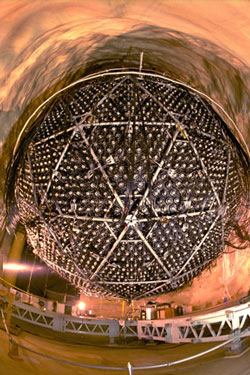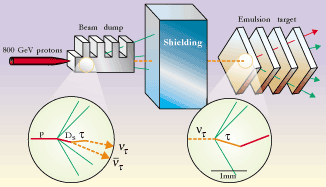



Connections Through Time, Issue 15:
April - June 2002
![]()
 |
|
| Shown here under construction,
the heart of the Sudbury Neutrino Observatory (SNO) is a sphere 12 meters
(39 feet) in diameter, surrounded by almost 10,000 photomultiplier tubes to
catch the faint flashes of Cerenkov radiation that mark the passage
of neutrinos through the heavy water filling the sphere.
The SNO is a unique neutrino telescope, the size of a ten-story building, two kilometers underground in Inco's Creighton Mine near Sudbury, Ontario, Canada. It was planned, constructed and is operated by a 100-member team of scientists from Canada, the United States and the United Kingdom. |
Neutrinos have the smallest mass of all known particles in our universe, and they come in at least three flavors. Would you like yours in vanilla, strawberry or chocolate? Okay, okay, the three flavors, or types, are electron, muon, or tau neutrinos. The neutrinos have no electric charge and are named after their associated negatively charged particle. The muon and tau particles are just like the electron, except more massive by factors of about 200 and 3,000 respectively.
In April 2002, a team of scientists associated with the Sudbury Neutrino Observatory, SNO, (see photo/description at right) reported their measurements concerning neutrino flavor-changing. The oscillations between neutrino types was clearly shown for neutrinos reaching the Earth from the Sun. The ability of a neutrino to oscillate between types with different masses is strictly a quantum mechanical feature.
Electron neutrinos are created in the hot furnace of our sun as strong gravitational pressure at the sun's core heats up and fuses the nuclei of its hydrogen and helium gases. As they fuse, they release energy, including X-rays, gamma rays, and electron neutrinos. The numbers of electron neutrinos observed on Earth are too low to be consistent with the total number leaving the Sun. The SNO team detected electron, muon and tau neutrinos to directly demonstrate the flavor changes. They showed that neutrinos from the Sun do change flavor (or "oscillate") from one type to another before reaching the Earth.
The electron neutrino is known to have a rest mass at least 2.5 million times smaller than the rest mass of the electron. However, since there are so many neutrinos, their total mass in the universe may be significant. One estimate is that for every electron, proton, or neutron in the universe, there are a billion or so neutrinos.
For a long time, neutrinos were considered to have no mass. The neutrino was first theoretically predicted in 1931 by Wolfgang Pauli to explain an apparent energy discrepancy when a neutron decays into a proton and an electron. To account for this discrepancy, he proposed in 1933 the existence of a new particle, the neutrino. He was uncomfortable with his proposal. "I have done something very bad today in proposing a particle that cannot be detected," Pauli told a friend. "It is something no theorist should ever do."
The neutrino was used by Enrico Fermi in 1934 as part of his comprehensive theory of radioactive decay. However, it wasn't until 1956 that scientists experimentally detected the neutrino. Clyde Cowan and Frederick Reines, of the Los Alamos National Laboratory, set up equipment near a South Carolina nuclear reactor, and managed to capture the track of an antineutrino. Good enough - if there's an antineutrino, there must also be a neutrino. Reines won the 1995 Nobel Prize in physics for the discovery. (Cowan died in 1974.)
Most neutrinos were created about 20 billion years ago, in the earliest moments after the Big Bang. The newborn universe was a hot, dense soup of elementary particles—among them, neutrinos. It is believed that there are today about a billion neutrinos per cubic yard of space that have survived since the days of the early universe. Neutrinos are constantly being created in stars, galactic dust, and from the fringes of black holes. The speed of neutrinos, and thus their total energy, vary from small fractions of the speed of light (for the neutrinos generated shortly after the Big Bang) to speeds approaching the speed of light.
Perhaps the most dramatic source of neutrinos is associated with supernovas, which are the explosion associated with some dying stars. In 1987, some 100,000 light-years away, a supernova (SN1987A) emitted 1,000 times more energy than our sun will produce in 4.5 billion years and was 20 times more massive. Researchers using large underground detectors in the Kamioka mine in Japan and in the Morton salt mine in the U.S. were able to detect 11 neutrinos that emerged from that violent explosion — 11 neutrinos may not sound like much, but physicists get very excited when there is hard evidence of their theories concerning the universe!
 Physicists
also create neutrinos in the laboratory using high-energy particle
accelerators. For example, the tau neutrino was first experimentally
observed at the Fermilab in the Tevatron particle accelerator using the DONUT
(an acronym for Direct Observation of the NeUtrino
Tau) detector. This result was reported in July 2000.
The Tevatron produces an intense beam of proton particles which impinges on a
chunk of tungsten which produces many particles including tau
neutrinos. Shielding and strong magnetic fields were used to
filter out essentially all the particles except the
neutrinos. The 50 ft. long and very sophisticated detector target
was placed 118 feet downstream. On a very rare occasion, a tau
neutrino interacted with an iron
nucleus (iron plates were sandwiched with layers of emulsion used for detection)
to produce a shower of particles including an observable
tau particle. This tau particle leaves a unique 1 millimeter long
"signature" in the emulsion and identifies the presence of a
tau neutrino.
Physicists
also create neutrinos in the laboratory using high-energy particle
accelerators. For example, the tau neutrino was first experimentally
observed at the Fermilab in the Tevatron particle accelerator using the DONUT
(an acronym for Direct Observation of the NeUtrino
Tau) detector. This result was reported in July 2000.
The Tevatron produces an intense beam of proton particles which impinges on a
chunk of tungsten which produces many particles including tau
neutrinos. Shielding and strong magnetic fields were used to
filter out essentially all the particles except the
neutrinos. The 50 ft. long and very sophisticated detector target
was placed 118 feet downstream. On a very rare occasion, a tau
neutrino interacted with an iron
nucleus (iron plates were sandwiched with layers of emulsion used for detection)
to produce a shower of particles including an observable
tau particle. This tau particle leaves a unique 1 millimeter long
"signature" in the emulsion and identifies the presence of a
tau neutrino.
The Tevatron produced, in five months of running, about 4 × 1017 protons that impacted the tungsten. It took 3 years for scientists, electronics and computers to filter through millions of particle interactions captured in the emulsions until 4 tau particle events were unambiguously observed to prove the existence of the tau neutrino. The neutrino is indeed elusive to a world that wants to see "solid" evidence.
Conjecture:
In the quantum mechanical (QM) world where
the neutrino lives, the neutrino may be crucial for connecting:
the world of particles (non-zero rest mass).
Neutrinos seem perfectly designed to straddle these two worlds because of their very small rest mass, their ability to change flavors, their close association with electrons, and their abundance. In your body, there is a dynamic QM "web" formed by billions of neutrinos and vast numbers of other particles. This web is a candidate for providing subtle QM interactions that may be related to consciousness itself through many (~1018) "tubulin" in the human brain. These tubulin are composed of tiny 25 nanometer (25 x 10-9 m) diameter microtubules.
References
Solar Neutrinos Really Do Change SNO (Sudbury Neutrino Observatory) sees flavor changes in neutrinos from the sun., April 22, 2002
Sensitive measurement by SNO observes solar neutrinos in a new way, April 20th, 2002
Solar Neutrinos, April 20, 2002
First Results from the Sudbury Neutrino Observatory Explain Missing Solar Neutrinos and Reveal New Neutrino Properties, July 18, 2001
Wow! Fermilab Confirms the Tau! (neutrino), July 21, 2000
Discovering the World of Neutrinos, July 1, 2000
UNIVERSAL PARTICLE New experiments show evidence of neutrino's cosmic significance, May 29, 2000
Fermi National Accelerator Lab's: Historical Events in Neutrino Physics - to the year 2000
New upper limit to neutrino mass, 22 November 1999
Super-Kamiokande results indicate neutrinos have mass and change "flavor" or oscillate, June 5, 1998
Particle weight in, just heavier than nothing, June 5, 1998
Discovery of Neutrino Mass and Oscillations, May 1998
Neutrinos Matter, Fermilab tutorial
There are many neutrino-related experiments being conducted all over the world.
Zero Point Energy (ZPE) References and Possible Applications
Go to another section of this
issue:
Intuition: Consciousness - How
fundamental is it? Applications:
Associative Remote Viewing Presentation at CRV Conference
![]()